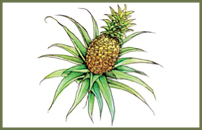Scientific Names: Sulfydryl proteolytic enzyme, cysteine proteinase
Common Names: Ananase, Dayto Anase, Traumanase
The use of dietary supplements by patients with cancer has increased significantly over the past 20 years despite insufficient evidence of safety and effectiveness. Finding reliable sources of information about dietary supplements can be daunting. Patients typically rely on family, friends, and the Internet, often receiving misleading information.
The ASCO Post’s Integrative Oncology series is intended to facilitate the availability of evidence-based information on integrative and complementary therapies commonly used by patients with cancer. We chose bromelain for this issue because of the growing interest in its anticancer potential.
Compiled by Barrie R. Cassileth, PhD, and Jyothirmai Gubili, MS, of Memorial Sloan Kettering Cancer Center. The free About Herbs website is managed by K. Simon Yeung, PharmD, MBA, LAc, of Memorial Sloan Kettering Cancer Center.
Overview
Derived from the fruits and stems of pineapples, bromelain is a proteolytic enzyme that is used to treat burns and skin conditions, and as an anti-inflammatory agent. Popularized in Germany in the 1960s, proteolytic enzymes are employed in the treatment of osteoarthritis, autoimmune diseases, and viral infections.
Available data indicate that bromelain is effective in reducing pain and inflammation, and as a debriding agent in the treatment of burns. Preliminary findings suggest its utility in controlling symptoms associated with cancer treatments. However, clinical data are limited.
Bromelain is available in health food stores and online in the form of tablets and capsules for oral use and in topical formulations. It is also marketed as a “digestive aid.”
The Science
Bromelain demonstrated anti-inflammatory,1,2 wound-healing,3 and fibrinolytic4 properties in vitro. Preliminary data suggest the safety and efficacy of a topical bromelain-derived agent in debridement in patients with second- and third-degree burns.5
Orally administered bromelain has been reported to be useful for the treatment of skin conditions6 and to alleviate mild, acute knee pain in a dose-dependent manner.7 Preoperative administration of bromelain was found to reduce pain and improve quality of life after oral surgery as well, and these effects were comparable to those with diclofenac sodium, a commonly used nonsteroidal anti-inflammatory agent.8 Data on its ability to relieve osteoarthritic pain are inconclusive.9,10

Jyothirmai Gubili, MS
Furthermore, preclinical studies indicate that bromelain exerts antitumorigenic11,12 and chemopreventive13,14 effects. It has also been used along with other proteolytic enzymes, as adjuvants to cancer treatments.15,16
The mechanisms underlying bromelain’s physiologic effects have been investigated. Its wound-healing effects were shown to occur via the improvement of ischemia-reperfusion injury17; and its anti-inflammatory actions were found to occur by decreasing the levels of prostaglandin E2 and thromboxane A21 and by activating fibrinolysis. In addition, bromelain inhibits neutrophil migration in response to interleukin (IL-8)2 and decreases the secretion of proinflammatory chemokine and cytokine.18,19

Proposed mechanisms of bromelain’s antitumor effects include downregulation of the immunosuppressive cytokine transforming growth factor beta (TGF-b),15 direct inhibition of tumor cell growth, as well as modulation of immune-cell function and cell-adhesion molecules.9 Bromelain also induced apoptosis-related proteins along with inhibiting nuclear factor-kB (NF kB)-driven cyclooxygenase-2 expression by blocking the MAPK and Akt/protein kinase B signaling in 7,12-dimethylbenz[a]anthracene- 12-O-tetradecanoylphorbol-13-acetate (DMBA-TPA)-induced skin tumors11; and induced expression of autophagy-related proteins, light chain 3 protein B II (LC3BII), and beclin-1, thereby facilitating apoptosis in mammary carcinoma cells.12
Adverse Reactions
Although serious adverse events are rare with the use of bromelain, allergic reactions have been reported following its topical use.20,21
Herb-Drug Interactions
Cytochrome P450 2C9: Bromelain inhibits CYP2C9 activity and may affect the metabolism of its substrates.22
Antibiotics/tetracyclines: Bromelain may increase blood and urine levels.23
Anticoagulants: Because of its antithrombotic property, bromelain may increase the risk of bleeding.24 ■
Disclosure: Ms. Gubili reported no potential conflicts of interest.
References
16. Desser L, Zavadova E, Herbacek I: Oral enzymes as additive cancer therapy. Int J Immunotherapy 17:153-161, 2001.

